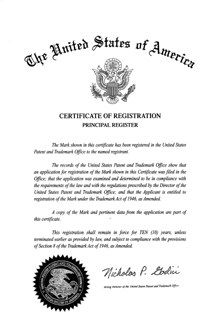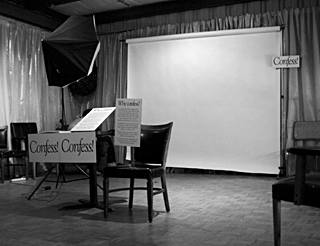
- 1 October 2001
- Stare®
- Acting Director of the United States Patent and Trademark Office Nicholas P. Godici sent me a handsome, gold-embossed certificate acknowledging, “The Mark [Stare] shown in this certificate has been registered in the United States Patent and Trademark Office to the named registrant [me!].
I usually fail to appreciate the work of tireless civil servants, but I am rather pleased learn that I finally own a registered trademark. I’m especially grateful to David Renard, the inept Frenchman who inspired me to begin the lengthy trademark process.
Renard tried to trademark “Stare,” but cleverly managed to use the wrong email address in his government application. (I would not argue with anyone who suggested that Renard is one of the dimmer bulbs in the French firmament.) After politely forwarding the misaddressed mail, I asked him to choose any name but “Stare” for his new publication. He refused, then he went out of business and vanished from the face of the earth.
Thank you, Monsieur Renard, and good riddance.

- 2 October 2001
- The Real CC
- I haven’t seen carbon paper in years until today. In the morning, a locksmith used a ragged piece of carbon paper to make two copies of a receipt at once: one for her, one for me. Very efficient!
In the afternoon, I saw a writer in a coffee shop scribbling on two sheets of notebook paper separated by a sheet of carbonated paper. (“Carbonated paper” is the phrase Ralph Wedgwood used in his 1806 patent for his Stylographic Writer.) Carbon paper is amazing!
Out of curiosity, I tried to see if I could find carbon paper for sale on the Internet. I checked out three of the largest online purveyors of office supplies and found lots of “carbonless paper,” but not a scrap of carbonated paper. I imagine carbon paper will soon vanish entirely, with only the “cc” (“carbon copy”) email field providing a vestigial trace.
Since 1806 was the first documented use of carbon paper, I suppose it’s only five years until we’ll celebrate the bicentennial of the invention of carbon paper. I wonder if I’ll see anyone there except the locksmith and the writer?

- 3 October 2001
- Learning Too Much About Pistachios
- You can learn a lot just by reading headlines. For example, I just discovered that pistachios take ten years to mature. Imagine that! I never realized every pistachio nut I ate was ten years old. Now I understand why pistachios are so expensive.
I decided that I’d enjoy pistachios even more if I learned more about said nuts. Big mistake.
It turns out that the pistachio plant itself—not the nut—takes a decade to reach maturity; the nuts take more or less the usual time to grow. The article noted, however, that the plant only bears a crop every two years. Yawn.
I should have turned the page after reading the headline. When it comes to pistachios, I’d much rather believe some interesting misunderstandings than know some tedious truths.


- 4 October 2001
- Unfortunate Cookies
- Everyone seems to agree that fortune cookies were invented in California. No one can seem to agree when, by whom, or in what city: Los Angeles or San Francisco? But who cares?
I’m concerned about the state of contemporary fortune cookies. Or, more accurately, I can’t understand why I haven’t seen a real fortune cookie in years. Or, to finally get to the point, I wonder why the stale Chinese-American novelty deserts now contain truisms instead of fortunes?
My piss-poor dictionary defines a fortune cookie as, “A cookie made from a thin layer of dough folded and baked around a slip of paper bearing a prediction of fortune or a maxim.”
I haven’t found a prediction inside a fortune cookie in years. Instead of useful information like, “You will be governed by an idiot,” or, “Wait until January before buying new toys,” I get useless, trite, and hackneyed bromides like tonight’s cliché: “The great pleasure in life is doing what people say you cannot do.”
Out of frustration, I started to write fortunes for real fortune cookies. I never got past the first one though, which was perfect. “You will not find any insights within a cookie.”


- 5 October 2001
- I Confess
- I wasn’t sure what would happen when I gave members of the audience at the Chaotic Art Circus in San Francisco the opportunity to make a documented, public confession. I told one of my assistants that I wouldn’t be surprised if no one took advantage of the opportunity, and that I would consider such an outcome to be an aesthetic success.
Instead, I was pleasantly surprised at the responses, and pleased with the initial results. Each participant thought for a bit, wrote a confession, signed the model release, then posed for a documentary photograph. Not bad, really.
Nevertheless, I look at the first set of confessions as sketches. If I continue with the project, I’ll employ a more thoughtful approach. I’ll probably ask each confessor to consider his or her statement for a few days before submitting it. Then, I’ll document the confession in a “real” environment, not a studio. (Although my ineptitude with studio photography resulted in some pleasing technical mistakes, I think I shall continue to avoid the studio, as I have since high school.)
If you’d like to make a public confession, please do. I don’t know whether or not I’ll be able to publish it and/or photograph you, but making a public confession couldn’t hurt.
Or could it?

- 6 October 2001
- The Most Beautiful Thing I’ve Ever Seen
- My life is full of beauty: beauty here, beauty there, beauty everywhere. It’s all very beautiful, very beautiful indeed. I only mention this wealth of beauty in order to put the next statement in perspective.
Last night I saw the most beautiful thing I’ve ever seen: Carl Pisaturo’s robots, Slave System Zero and Slave System One.
Pisaturo’s robots were different than any other robot I’ve ever seen or imagined. Slave System Zero and Slave System One looked like mechanical mermaids, or perhaps a human torso mounted on a cone of metal rods.
When I inspected the robots before the show, their chests, arms, and heads didn’t look human at all; Slave System Zero and Slave System One looked like intricate sculptures.
But that was before they began to move.
Slave System Zero and Slave System One moved with a precision, smoothness, grace, and perfection that no two human dancers could match, for hours on end. They never breathed, never sweat, and never erred. They followed the choreographer’s instructions with icy steel perfection.
Last night I saw the most beautiful thing I’ve ever seen.

- 7 October 2001
- Burritos and Bhutto Dancing
- Bhutto dancing is one of those things one hears about but never sees. According to the stories I’ve heard, a troupe of exotic dancers used to entertain Zulfiqar Ali Bhutto, the prime minister of Pakistan in the mid-1970s.
Now here’s the interesting part: were the dancers men and/or women?
Some accounts tell of spectacularly beautiful Pakistani women in exotic costumes performing beguiling and enchanting dances for Bhutto and his cronies. I’ve also heard claims that, in deference to religious strictures, all of the dancers were, in fact, men.
One of the few people who could answer the gender question is forever silent. General Zia ul-Haq staged a military coup in 1977; his regime hanged Zulfiqar Ali Bhutto in 1979. And that was the last anyone heard about Bhutto dancing.
Until yesterday.
Alicia told me that some folks were hosting an evening on Bhutto dancing with free burritos! What an absolutely brilliant idea!
Since there’s no such thing as a free burrito, I was happy to slip a few dollars in a donation box before heading for the roll-your-own burrito buffet. I couldn’t figure out why the hosts offered steamed rice until the program began.
It turns out that the evening had nothing to do with Bhutto dancing, nothing at all. Instead, I found myself listening to an earnest young man talking about Butoh dancing. I’m sure the lecturer was passionate about his subject, but I couldn’t help feel that I was listening to the dance equivalent of a gynecologist describing why women are so wonderful.
Fortunately, the academic introduction was reasonably brief. And then, an attractive Japanese Butoh dancer named Takami yanked me out of my burrito-enhanced insentience by performing some of her work. I’m as incapable of describing the dance as most other people, so I’ll just say that I thought her performance was memorable.
I can’t be certain, but I don’t think there’s any relationship between Bhutto dancing and Butoh dancing.

- 8 October 2001
- French Hangover
- Lucile invited me over for a delicious dinner last night. (Lucile has a limited kitchen repertoire; she can only prepare wonderful food.) After dinner, we told lies and jokes.
Lucile insisted on telling me a joke in French, even though I tried to dissuade her. I respected her tenacity; how could I not? After all, no one can stop me from telling a joke, especially a really terrible one.
She told the joke, then of course had to explain that the punch line was a double-entendre. In French, “testament” means both a section of the bible as well as a will, as in last will and testament.
“Just like English,” I said.
“Just like English,” Lucile agreed.
Lucile went on to provide an interesting linguistic perspective on “will and testament.” She explained that some French guy conquered England quite some time ago, and that he then mandated that laws be described in both French and English. That’s why we have “will and testament,” “assault and battery,” and so on.
I appreciated the historical perspective; it was the perfect way to drive the last bit of life out of a joke that wasn’t very healthy in the first place.


